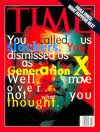 Generation X’ers have a unique perspective on information technology. Born in the sixties, this generation had their primary education in the old world of print and analog technologies, and their secondary education and first jobs in the new world of digital information technologies. I participated in the transformation of my family’s printing business, from old style presses to digital typesetting and copying. Having a foot in both world allows for a two-step, a dance between worlds.
Generation X’ers have a unique perspective on information technology. Born in the sixties, this generation had their primary education in the old world of print and analog technologies, and their secondary education and first jobs in the new world of digital information technologies. I participated in the transformation of my family’s printing business, from old style presses to digital typesetting and copying. Having a foot in both world allows for a two-step, a dance between worlds.
The two-step is a universal pattern. On the surface we see opposites: male and female, old and young, hot and cold. As we investigate the nature of things we see that opposites are only rough lumpings, changing based on other two-step patterns: diverging and converging, ascending and descending, ordering and disordering. The Chinese call it yin-yang, the dependence between seemingly contrary forces. To understand anything we dance the two-step.
The two-step is evident in the shifting trends of information technology. Once upon a time, centralized mainframes was the dominant computing paradigm. This gave way to a decentralized model, with powerful desktop and rich client applications. These days we are seeing a return to a centralized cloud computing model. Take too the the alternating visions of computer intelligence. In the early days of computing we imagined artificial intelligence thinking for us. Contrast that vision with Web 2.0, which hails user participation at the source of computing intelligence. Now look ahead. Web 3.0, the semantic web, is about machines working intelligently together with no human involvement.
Critical theory tells us to look for subtext, a second layer that explains what is really going on. Web 2.0 was seen as a technology in a new ‘flat’ world, in which business people could compete on a level playing field. Web 3.0 uses XML to let machines talk to each other. While XML is an open data format, it is also a hierarchical data format. Data exchange must be modelled in a structured format. The history of critical theory informs us that structuralism leads to authoritarianism. Sound far-fetched? Unlike Web 2.0, only trained programmers are going to know how to use the technologies of Web 3.0. Power is shifting back from the central population to a particular class of users. The shadow side of the digital divide is about to get a lot more company.
Duplicity is at the heart of digital technology. To duplicate is to make a copy. The web is a giant copy machine. The ease of copying is a technical wonder, a boon for all of us seeking and producing information. It also poses legal and ethical challenges for those seeking to harbour their intellectual products.
Can we use the two-step to better understand and benefit from information technology? Double-coding is an aesthetic technique used in architecture, incorporating older more familiar elements with the new, rendering design less brutal. This approach might make for a gentler web.
Information technology is the new light for knowledge. Can we evaluate it while using it? It is a double bind. Lacking external reference, can we bootstrap our way to insight? Perhaps we can use a peripheral vision of sorts, creating a self-reference though a symbolic token. Gödel’s incompleteness theorem informs us that this approach will have a blind spot but we can be aware of that too. This approach is inline with the concept of small narratives, the telling of personal stories without worrying about contradictions. One day I rave on about how much I love a new gadget, and the next day I complain how much time it is wasting. We can change hats, two-step style.
Philosophers considered how to balance opposites. Hegel said that the dialectic is resolved in higher consciousness. Buddhists say there is no ultimate essence to things while still serving the practical world where things seem to matter. It is a recognition that life is a narrative in progress across time. I might die tonight, but most likely not. In complexity theory, they use the phrase, the “edge of chaos”, for the balance point of chaos and order. It is the point at which organization emerges from complex systems.
Evaluating information technology is not really such a thorny problem. We do not rely exclusively on information technology. We use our noggins. We talk with each other. We read books. It takes a GenX to notice that to reflect is like bending a page. Bending book pages to flip back and forth as read an author’s challenging new idea. Bending the corner of a page to cross reference it. Bending a page is something you can’t do with an ebook. That we still use so many types of technology, both old world and new, is itself an evaluation of digital technologies, placing them as only one tool in more complex context.
(this post concludes the “I, Reader – Critical Theory” series
Editor’s Note: you can read the earlier articles in this series in John’s I, Reader blog. PB.

































